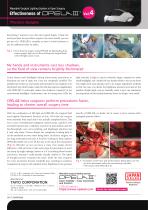 Website:
OPELAIII
Website:
OPELAIII
Group: Taiyo Corporation
Catalog excerpts

Dr. Ichiro Yoshino Professor, Department of Thoracic Surgery, Graduate School of Medicine, Chiba University In the field of thoracic surgery, video-assisted thoracic surgery (VATS) has markedly increased, but open thoracotomy remains the standard practice depending on the stage of the disease, and many surgeons prefer hybrid VATS with minor thoracotomy and thoracoscopy combined. Headlights are used very frequently in such open surgery which requires examining inside the thoracic cavity directly with one’ eyes. s This time, Dr. Ichiro Yoshino of Chiba University shared with us about the beneficial features of OPELAⅢ as compared with conventional light sources in lung cancer surgery through hybrid VATS (minor thoracotomy) and mediastinal tumor surgery (median sternotomy). Regardless of area, it is effective in both minor thoracotomy and extended surgery I used OPELAⅢ during a hybrid VATS lobectomy of left lung and mediastinal malignant tumorectomy through median sternotomy. Initially, I was using a thoracoscope in conjunction with OPELAⅢ to provide ample light in the surgical field. However, during operation it became apparent that the light from OPELAⅢ alone was more than enough therefore I chose to turn off the light of the thoracoscope, and had no problem completing the surgery. To remove the anterior mediastinal malignant tumor, a median sternotomy approach was taken. While OR lights usually provide sufficient brightness in the shallow region, using OPELAⅢ together proved to enhance visibility vividly (Fig. 1). I was most impressed with OPELAⅢ when it came to illuminating deep cavities. Normally, when looking down into deep areas, we need the help of another light source because the OR light on the ceiling cannot reach the depths or the surgeon’s head and instruments cast shadows over the surgical field. Until now we were using headlights or the camera on thoracoscopes to light up certain spots, but with OPELAⅢ, we performed the surgery with hardly any stress because it allowed us to easily recognize visually the hilar area as well as the pericardial space (Fig. 2). Fig. 1 he view with/without OPELAⅢ during small thoracotomy T ON means when OPELAⅢ is lit. Fig. 2The view near the hilar area. It is visible into the depths with OPELAⅢ. ON means when OPELAⅢ is lit. OPELAⅢ becomes even more beneficial when the procedure demands greater precision I was initially thinking of performing lateral thoracotomy in addition to median sternotomy because a diaphragm plication and nerve grafting were necessary as the lesion was extended to the left hilar area (phrenic nerve invasion). However, OPELAⅢ provided exceptional visibility beyond expectation therefore eventually only median sternotomy was sufficient. This was achieved because OPELAⅢ can point the light in the direction of my head’s movement, illuminating where I want to see even into the depths (Fig. 3), and improving visibility of the surgica
Open the catalog to page 1
Wearable Surgical Lighting System in Open Surgery VoM Thoracic Surgery Everything I wanted to see this time looked bright. I think the more precision the procedure requires, the more benefit you can get out of it. OPELAM is certainly an item I would continue to use for additional value on safety. Fig. 3 I Scene from the surgery using OPELAM. By illuminating from various angles, light can be directed deep into surgical fields where OR light cannot reach. My hands and instruments cast less shadows, so the field of view remains brightly illuminated I have always used headlights during...
Open the catalog to page 2All OPELAIII catalogs and technical brochures
-
OPELA III BROCHURE
2 Pages
-
OPELA III Instruction Manual USA
28 Pages
-
OPELA III Instruction Manual
28 Pages











